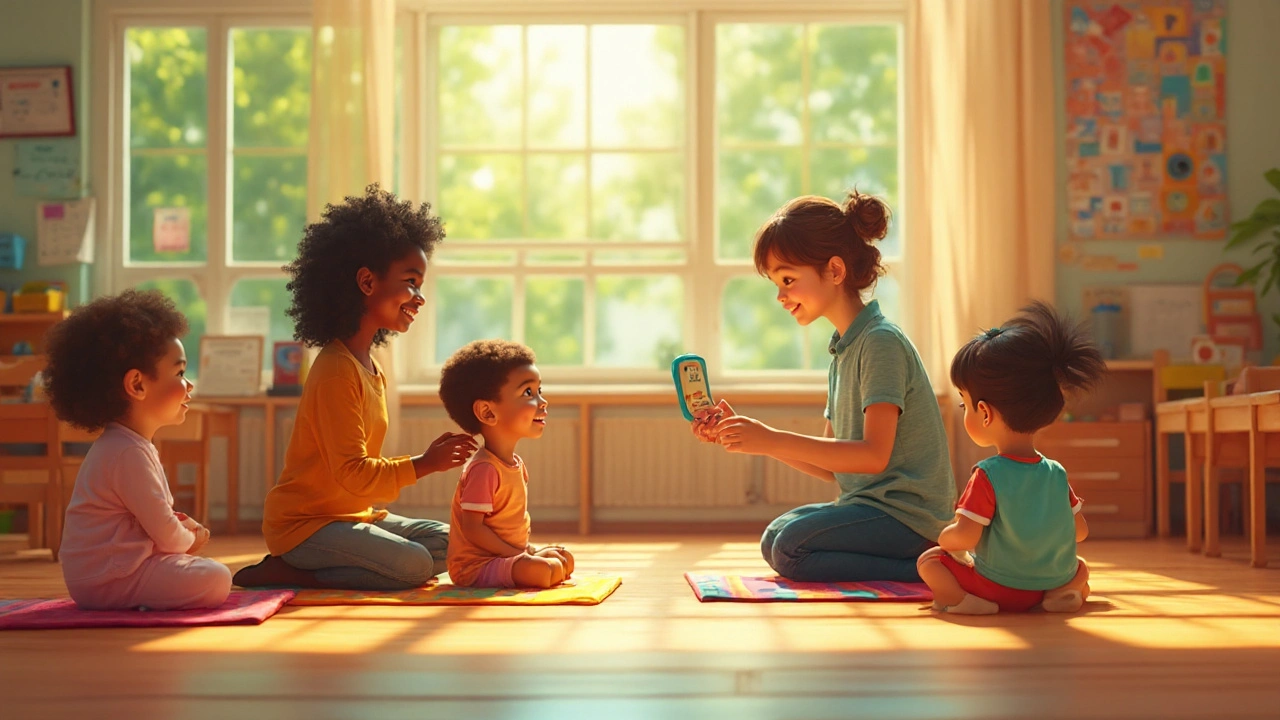How Hearing Loss Affects Speech Development in Children and What Parents Can Do
 Sep, 24 2025
Sep, 24 2025
Hearing Difficulty in Children is a condition where a child’s ability to detect or interpret sounds is reduced, affecting communication and learning. When a child can’t hear clearly, the road to spoken language becomes riddled with extra turns. Parents often wonder why a toddler who seems fine socially might lag behind in forming words. The answer lies in how sound fuels speech. Below we break down the science, the warning signs, and the practical steps families can take to keep language development on track.
Why Sound Matters for Speech Development
Speech doesn’t emerge from a vacuum; it builds on a child’s ability to hear the pitch, rhythm, and volume of the voices around them. Auditory input is the raw material that the brain reorganizes into phonemes, the smallest units of sound. If the input is muffled or missing, the brain’s language network receives an incomplete blueprint, leading to delays or atypical speech patterns.
Research from the National Institute on Deafness and Other Communication Disorders shows that children with untreated moderate‑to‑severe hearing loss children are, on average, two to three years behind peers in expressive language scores by age five.
Key Milestones Affected by Hearing Difficulty
- Babbling (6‑9 months): Babies start experimenting with sounds they hear. Reduced audibility often results in limited babble varieties.
- First words (12‑18 months): Without clear exposure to adult speech, children may use gestures longer before vocalizing.
- Vocabulary spurt (2‑3 years): A sudden increase in word count can be blunted or delayed when the auditory foundation is shaky.
Missing these milestones doesn’t mean a child can’t catch up-early detection is the catalyst.
Early Detection: Universal Newborn Hearing Screening and Beyond
Most developed health systems now implement Universal Newborn Hearing Screening a quick, non‑invasive test performed within the first month of life to flag potential hearing loss. The test uses otoacoustic emissions (OAEs) or automated auditory brainstem response (AABR) to assess ear function. Babies who fail the screen are referred for diagnostic audiology within six weeks.
Beyond the newborn period, parents should stay vigilant for these red flags:
- Failure to startle at loud noises.
- Consistently missing spoken directions.
- Frequent ear infections (otitis media) that seem to impact hearing.
- Limited vocal play or reliance on gestures.
If any of these appear, schedule an appointment with an Audiology professional who evaluates hearing sensitivity and recommends interventions specialist.
Intervention Strategies: From Hearing Aids to Speech Therapy
Once a hearing difficulty is confirmed, a multi‑disciplinary plan kicks in. The two main technology pathways are hearing aids and cochlear implants, each suited to different hearing profiles.
| Attribute | Hearing Aid | Cochlear Implant |
|---|---|---|
| Invasiveness | Non‑surgical, fits in or behind the ear | Requires surgery to place internal electrode array |
| Suitable Hearing Loss Level | Mild to severe (up to ~70dB loss) | Profound loss (>70dB) where hearing aids provide limited benefit |
| Typical Age for Fitting | As early as 3months with custom molds | Usually after 12months, contingent on medical clearance |
| Cost (USD, average) | 1,200‑3,500 per device | 20,000‑40,000 including surgery |
| Speech Perception Gains | Improved word recognition (30‑50% increase) | Significant gains in noisy environments (70‑90% increase) |
Choosing between the two depends on the child’s audiogram, medical considerations, and family preferences. Regardless of the device, success hinges on timely fitting and consistent use.
Technology alone isn’t enough. Speech‑Language Pathology the clinical field that assesses and treats communication disorders provides the language scaffolding children need. A speech‑language pathologist (SLP) works on:
- Auditory discrimination exercises.
- Articulation drills for specific phonemes.
- Parent‑coaching strategies to reinforce speech at home.
Research from the American Speech‑Language‑Hearing Association shows that children receiving combined device + SLP therapy achieve age‑appropriate vocabularies 1.5 years sooner than those with device alone.
Early Intervention Programs: Turning Detection Into Action
The moment a hearing loss is identified, Early Intervention a set of services designed to support infants and toddlers with developmental delays should be triggered. In Australia, the National Disability Insurance Scheme (NDIS) funds early childhood support, covering:
- Device procurement (hearing aids or cochlear implants).
- Weekly speech‑language therapy sessions.
- Parental training workshops.
Early intervention reduces the risk of academic difficulties later in school, cutting the need for remedial services by up to 40%.

Parent’s Role: Creating a Sound‑Rich Environment
Parents are the most powerful language models. Even with technology, children need clear, consistent auditory exposure. Here are three practical habits:
- Face-to-face talk: Keep your face within 12inches, articulate slowly, and repeat key words.
- Use visual cues: Pair words with gestures or pictures to reinforce meaning.
- Limit background noise: Turn down TV volume during conversation; choose quieter play settings.
Tracking progress is easier with a simple language log. Note new words each week, describe the context, and share the log with the SLP during appointments.
Monitoring Progress: Auditory and Language Benchmarks
Regular check‑ins with an audiologist and SLP allow the team to adjust settings or therapy focus. Key indicators include:
- Improved pure‑tone thresholds (measured in decibels).
- Higher scores on standardized language assessments (e.g., Preschool Language Scale).
- Increased spontaneous speech during play.
If progress stalls, consider a re‑evaluation for possible auditory processing disorder or the need for supplemental assistive listening devices (e.g., FM systems in classrooms).
Common Misconceptions and Realities
1 My child will “outgrow” hearing loss. - Very rare; most sensorineural losses are permanent.
2 Hearing aids are only for severe loss. - Modern digital aids benefit children with mild loss by amplifying speech frequencies.
3 Speech therapy isn’t needed if a device is used. - The brain still needs training to translate amplified sound into meaningful language.
Related Concepts Worth Exploring
Understanding hearing difficulty opens doors to adjacent topics such as auditory processing disorder, language delay versus speech delay, and the impact of chronic otitis media on learning. Parents who master the basics often ask about classroom accommodations, assistive technology for group settings, and long‑term academic outcomes. Those are natural next steps after establishing a solid foundation at home.
Frequently Asked Questions
How soon after birth can hearing loss be detected?
Universal newborn hearing screening is typically completed before the baby leaves the hospital, usually within the first 24‑48hours. If the infant fails the screen, a diagnostic audiology appointment should be scheduled by six weeks of age.
Can a child use a hearing aid and a cochlear implant at the same time?
In rare cases where residual low‑frequency hearing remains, a hybrid approach called a “hearing‑preserving cochlear implant” may be used alongside a traditional hearing aid. This strategy is evaluated individually by an audiology and otology team.
What age is best to start speech‑language therapy?
Therapy can begin as soon as a hearing loss is identified, often as early as three months with a hearing aid in place. Early intervention capitalizes on the brain’s plasticity and leads to the most robust language gains.
Do hearing aids require regular adjustments?
Yes. As a child’s ear canal grows and their listening environments change, audiologists recalibrate amplification levels every 3‑6months, and more frequently during rapid growth phases.
How can I support my child’s speech at home?
Engage in ‘one‑on‑one’ talk time, narrate daily activities, repeat new words, use picture books, and maintain eye contact. Consistency beats occasional intensive sessions.


Caden Little
September 26, 2025 AT 05:06Just had my 18-month-old tested after noticing she wasn’t responding to her name-turns out she’s got moderate sensorineural loss. Got hearing aids fitted last week and already, she’s babbling more. It’s not magic, but it’s a start. Don’t wait for ‘she’ll outgrow it’-she won’t.
Sebastian Brice
September 26, 2025 AT 14:00Wow, another parent who actually reads the research instead of just googling ‘baby not talking’ and blaming the daycare. Respect. I wish more people knew that amplification ≠ language. The brain needs training, not just louder noise.
Jim Aondongu
September 27, 2025 AT 08:56Michael Schaller
September 28, 2025 AT 03:51My daughter got diagnosed at 11 months. We did the hearing aids, started therapy at 4 months post-diagnosis, and now at 3 she’s reading picture books aloud. It’s not perfect, but it’s progress. The key? Consistency. Not perfection. Just show up, every day, even when you’re tired.
Kyle Tampier
September 28, 2025 AT 13:13Tom Caruana
September 30, 2025 AT 04:22OMG I cried reading this. My son got his cochlear implant at 14 months and the first time he said ‘mama’… I lost it. Like full sobbing on the floor. I didn’t know you could feel joy like that. Also, I now have a spreadsheet tracking every new word. 47 words this week. 😭💖
Muzzafar Magray
October 1, 2025 AT 06:50Renee Williamson
October 3, 2025 AT 06:30So I just found out my 2-year-old has mild loss and now I’m convinced the school is hiding it because they don’t want to pay for aides. I’ve been recording everything. I’m going viral with this. #HearingLossCoverUp #SaveOurKids
Manish Mehta
October 3, 2025 AT 12:48My brother’s kid got hearing aid. Now he talks. Good. Simple. No need to overthink. Just do what the doctor says.
Okechukwu Uchechukwu
October 4, 2025 AT 11:00It’s ironic, really. We spend thousands on devices to hear speech, yet we live in a world drowning in noise. Maybe the real problem isn’t hearing loss-it’s that we’ve forgotten how to listen. The child isn’t broken. The environment is.
Sarah Cline
October 5, 2025 AT 07:00Just wanted to say-you’re not alone. I was scared to start therapy because I thought I’d ‘fail’ as a mom. Turns out, showing up is the win. My daughter said ‘ball’ for the first time after 8 weeks of play-based therapy. I screamed. Then I made pancakes. Best breakfast ever.
Sierra Thompson
October 5, 2025 AT 13:29Is it possible that language development isn’t just about hearing? What if the child’s emotional state, attachment, or trauma plays a bigger role? We reduce everything to biology, but the soul doesn’t have decibels.
Alexis Hernandez
October 6, 2025 AT 17:53My kid’s audiologist said to talk like you’re narrating a nature documentary-slow, clear, descriptive. So now I say things like, ‘Look at the red bird hopping on the wobbly branch.’ He’s 2. He gets it. Turns out, being weirdly poetic helps. Also, he loves the sound of my voice. Weirdly comforting.
brajagopal debbarma
October 8, 2025 AT 08:08Carly Smith
October 8, 2025 AT 11:54My daughter’s speech therapist told me to stop saying ‘say ‘ball’’ and just say ‘ball’ while holding it. I thought she was joking. Turns out, I was doing it wrong. Now she says it. I feel dumb. And also, kinda proud?
Kurt Stallings
October 8, 2025 AT 23:39Angie Creed
October 10, 2025 AT 09:27They say early intervention helps. But what if your child is adopted? What if you’re a single mom working two jobs? What if you can’t afford the co-pay? This isn’t about science-it’s about privilege. And I’m tired of being guilt-tripped because I didn’t catch it at 3 months.
Michael Ferguson
October 12, 2025 AT 03:48Let me tell you something you won’t hear from the audiologists. My son had profound hearing loss. We got cochlear implants. He’s now in a mainstream school. But here’s the truth-no one talks about the meltdowns. The sensory overload. The exhaustion. The 3 a.m. tears because he still doesn’t understand sarcasm. The therapy isn’t a cure. It’s a lifelong marathon. And the system doesn’t prepare you for the emotional toll. They sell you hope. They don’t tell you about the grief that comes after.